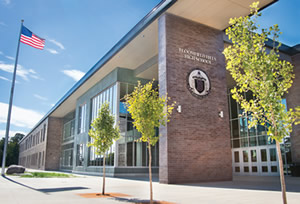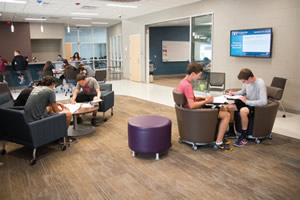A Learning Ecosystem in Action

PHOTOS BY LAUREN DIAMOND, COURTESY OF BLOOMFIELD HILLS SCHOOLS
“Broadly speaking, a learning ecosystem is an intentional, plan-full design of the student experience, both what can be seen (whiteboards, tables and chairs) and what can’t be seen (data, research, planning, systems),” says Dalia Hochman, Ph.D., director of K-12 Model Development and Adoption at Washington-based Next Generation Learning Challenges (NGLC), which was founded in 2010 by EDUCAUSE to accelerate educational innovation through applied technology to dramatically improve college readiness and completion. “When I think about ecosystems, I think about the natural world with relationships among many different species. A school has those relationships, too. There are many adults who have different roles to fulfill for and with students and among themselves, such as transportation, food service, teachers and principals. It’s a complex environment, so I think the terminology is quite apt.”
Administrators at Bloomfield Hills Schools (BHS) in Michigan, have recently built a new learning ecosystem — Bloomfield Hills High School (BHHS) — in which they implemented change management strategies to develop not just a facility, but a new way of teaching and learning. In building BHHS, they thoughtfully included three learning ecosystem elements — flexible furnishings, engaging technologies and collaborative spaces. Here’s the story.
Developing and Implementing the Concept
“We had two very successful, comprehensive high schools that were experiencing declining enrollment as a result of declining birthrates in the region,” begins Rob Glass, Ph.D., BHS superintendent. “Plus, the buildings were aging and declining in investment. So it made sense to bring them together and build a high school with a great ecosystem that would be a better place to teach and learn.
“We constructed a hybrid school,” Glass continues, “in that we tore down twothirds of one of the high schools, renovated the remaining one-third and added new construction. It was cost efficient, and it appealed to the tax payers.”
More than a new facility, administrators wanted to bring education into the 21st century with technology-rich, projectbased teaching, and the community had a desire for smaller schools, which led to the idea of small-scale learning communities. To assist with the process of changing education and designing the school, BHS administrators hired Fielding Nair International, a planning and architectural design firm that helps clients define the future of education in their communities and provides the services to successfully implement change management strategies. “They collaboratively worked with the staff to see what we could do — how the school could look and function,” says Glass.
It was decided that the school would be built on four cornerstones, determined by the staff based upon their beliefs in teaching and learning. They are responsibility/ownership, relationships, authentic learning and innovation, which are the foundation upon which curriculum, scheduling, collaboration and interactions are based and are important qualities required for successful learning communities. How the learning communities would be used would be driven by the cornerstones.
To begin the process, three years ago, both schools’ 10th, 11th and 12th grade student bodies were combined in the high school that would not be part of the new construction. Because neither school was large enough to house the entire student body, 9th graders were situated in an empty elementary school. “We stressed that we were one school and that this was temporary,” Glass explains.
“Then we asked, ‘How is the new school going to operate?’” Glass continues. “We asked teachers to take small steps — steps that weren’t so grandiose and that could be written down and for which they could be held accountable. It was creative. We tried different things. That was the first year, and it got things moving.”
The next year, staff worked on becoming comfortable with small learning communities. “We modified the classrooms a bit to function as learning communities,” says Glass. “We mocked up in the old building what we were going to do in the new building, such as movable walls and flexible furniture. We asked teachers to report on how it worked. This was a time to practice before getting into the new space.”
And, in the fall of 2015, staff and 1,700 students from all four grades moved into the new school, already familiar with the small learning community concept and excited because it was so much easier to practice in the new space. “Fielding Nair assisted us throughout the transition,” says Glass. “It’s hard enough to do your day job, so the extra support during this time was beneficial. Even now, it’s easy to regress to old paradigms without support.”
The learning communities concept offers increased collaboration and interdisciplinary connections, greater personalization for individual student needs and experiences, stronger relationships between staff and students, and an elevated community climate. “We’re finding all these elements to be true,” Glass says. “Take collaboration, for example. You don’t see 25 students in a classroom with one teacher at the front. You see students spread throughout a classroom tending to the projects they need to accomplish.”

PHOTOS BY LAUREN DIAMOND, COURTESY OF BLOOMFIELD HILLS SCHOOLS
Adaptable spaces. Bloomfield Hills High School, in Michigan, is designed so that each learning community, accommodating 150 students and six interdisciplinary teachers, is housed around a commons area. Each of the communities includes five different-sized and -shaped learning studios with different surfaces and finishes. Groups of students can be split into any configuration because of the use of movable doors and walls, allowing the studios to be opened in almost every direction, including into the commons area.
Flexible Furnishings
“From my perspective,” says Hochman, “an educator shouldn’t find furnishings and then adopt an education plan, but should purchase furniture after a clear plan emerges. Especially as the tools available to teachers increase, it becomes possible to group students in a number of flexible ways, and flexible furnishings enable that.
“We see more and more classroom environments with flexible seats that allow for a mixed pedagogical approach,” Hochman continues, “such as small groups, independent study, whole group instruction and technology instruction. And flexible furnishings enable that diverse pedagogical approach.”
At BHHS, furniture is flexible, with the intent of optimizing screen visibility. “Most everything is on wheels,” says Glass. “This includes classroom tables of varying heights that can be combined to accommodate varying-sized groups.” Commons areas include soft seating.
Engaging Technologies
“Technology is similar to furniture in that, once an education plan is in place, teachers look for engaging technologies, in terms of both computers and software,” says Hochman. “There are many online software programs that provide content and curriculum. But what is chosen should be vigorous and engaging, and it should align with the program. Technology falls short when educators see it as a way to fill time or that doing math on a computer ‘is enough.’ Technology must be engaging and fit with the classroom program. This is not new; teachers always look for engaging ways to deliver education. Indeed, finding new ways to teach student content is the thrill of the profession.”
With technology, BHHS is a learning environment that embraces 21st-century learning. That environment boasts a collegiate atmosphere with lots of media bars and places to use technology and one in which students are encouraged to bring their own devices. “What we offer is open source program apps under the Google Cloud Platform; wireless connectivity; and screens, interactive whiteboards and writable glass (most of the walls/cabinetry are writable, too) for display,” Glass explains. “It’s designed to be easy to collaborate digitally wherever you are.”

PHOTOS BY LAUREN DIAMOND, COURTESY OF BLOOMFIELD HILLS SCHOOLS
Collaborative Spaces
“Furniture and technology is tied together by collaborative space,” says Hochman. “Where we’re seeing innovative design is when furniture and technology are set up to foster different kinds of activities that engage students. Sometimes that’s alone, such as a cozy bean bag chair for individual reading. Sometimes that’s in a group requiring a table. When we enable these spaces, it gives teachers the ability to move around and manage classrooms in different ways.”
BHHS is designed so that each learning community, accommodating 150 students and six interdisciplinary teachers, is constructed around a commons area. Each community includes five different-sized and -shaped learning studios with different surfaces and finishes. “Thanks to the use of movable doors and walls, the studios can be opened in almost every direction, including the commons area, to co-teach,” describes Glass. “Students can be broken up into any configuration desired.”
The teachers don’t have classrooms that are theirs all the time; instead, classrooms are scheduled according to instruction and purpose. They’re scheduled on a per unit/per day/per week basis with the idea that, when you add technology, there’s greater flexibility. “Teachers in each learning community also have a shared office for planning and collaborating casually with each other,” Glass indicates.
“You can make the argument for the here and now that the traditional, comprehensive American high school does not appear to be broken,” says Glass. “But we know things are changing fast, and there are clichés about preparing students for careers that haven’t been envisioned yet. That’s true, too. So how do you get the best of both worlds? How do you shift without people saying, ‘You’ve gone too far too fast’? This was a good evolution for us to keep moving forward.”
BHS administrators built a high school that allows them to move into 21st century education, providing an environment that’s pleasant and easily adaptable to what the learning task requires. It also serves as a strong example of a learning ecosystem in that there’s synergy between all the elements that support education and work together to leverage the learning process, including flexible furnishings, engaging technology and collaborative spaces — and also including the relationships of students to students, teachers to teachers, and teachers to students.
Volumes of Wisdom
What’s the takeaway from Glass’ experience of building a new learning ecosystem and serving as a change agent? “When you’re working on a change of this magnitude, do it with creativity and on an inspirational platform. For example, we grounded our values around what we call our 10 Bloomfield Hills Guiding Principles for Teaching and Learning (see below). This allowed us to paint a word picture and build agreement about who we want to become as a school and district.
“Once that’s in place,” Glass continues, “it’s important to try to create an environment where you’re making changes with people and not to people. Acknowledge the stress that’s on your staff as a result of the change. For example, you may say, “I know you want to do it but can’t do it that fast, so how about this step first.” Then staff is willing to invest in the change and enjoy it. People are willing to reach as long as they feel supported and not pushed upon.”
10 BH Guiding Principles for Teaching and Learning
- The curriculum makes time for depth by thoughtfully managing the number of standards (“less is more” concept).
- Content knowledge, while important, ceases to be the primary learning outcome, becoming a vehicle to support higher levels of thinking (application, analysis, synthesis, evaluation, creation).
- Deep student ownership and control of learning. Teaching shifts to facilitation.
- Strong, caring relationships and very high levels of collaboration among/between staff and students.
- A culture that embraces risk-taking in the learning process believing that sometimes more is learned from failure than success.
- Project-based/inquiry-based interdisciplinary learning boosts critical thinking and creativity by allowing students to frame problems and construct their own solutions.
- Learners are connected to the world outside the school.
- Engagement in meaningful work that increases learner passion and motivation.
- Technology tools are readily available and easily accessible to support personal learning.
- Staff share a commitment to a small set of clearly understood, annually identified, generally agreed upon, non-negotiable instructional goals.
This article originally appeared in the issue of .